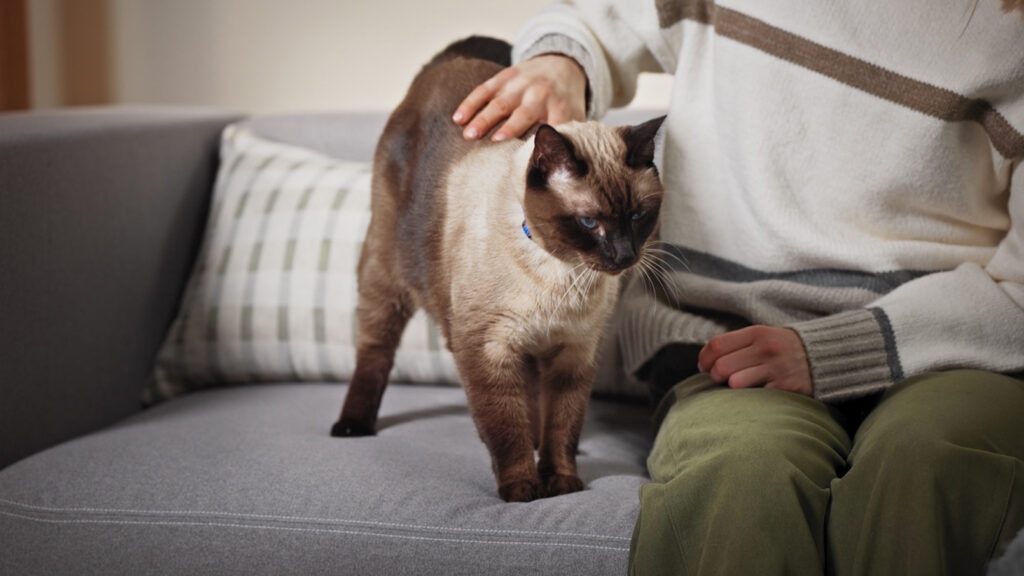Cat Blindness: Signs, Causes, and How To Help a Blind Cat

Photo by Chewy
Are you noticing your cat bumping into furniture or hesitating before jumping up on their favorite perch? It might be more than just a clumsy moment. Cat blindness can sneak up slowly or happen suddenly, and either way, it can be tough to watch your once-confident kitty seem unsure of their surroundings.
The good news is that, in some cases, cat blindness can be reversed. But even when it can’t, blind cats can still live full, happy lives with a bit of extra support from you.
In this guide, we’ll cover the signs and causes of cat blindness, along with practical tips to help your visually impaired kitty feel safe, confident, and cared for.
Key Takeaways
- Cat blindness can develop gradually or suddenly.
- Some signs of vision loss include bumping into things, seeming disoriented, and having cloudy eyes or pupils that don’t react to light.
- Blindness in cats can be caused by a range of issues, including high blood pressure, infections, injuries, or inherited conditions.
- With a consistent routine and a few adjustments at home, blind cats can live full, happy lives.
How To Tell if Your Cat Is Going Blind
Felines are masters at hiding changes in their health, but vision loss in cats tends to have some telltale clues.
Some common signs of blindness in cats include:
- Bumping into furniture or walls
- Hesitating before jumping or walking on stairs
- Dilated pupils that don’t respond to light
- Cloudiness or discoloration in the eyes
- Increased vocalization or clinginess
- Appearing disoriented, especially in new environments
If you notice any of these changes, it’s time to schedule a vet visit as soon as possible.
During a physical exam, a vet will check your cat’s vision using several reflex tests, says Diana Pate, DVM, DACVO, a board-certified veterinary ophthalmologist at Carolina Animal Eye, in Greenville, South Carolina. These tests may include:
- Menace response: Silently waving a hand near the cat’s face (without touching or creating wind) to check for a blink or flinch
- Pupillary light reflex (PLR): Shining a light into the eye to see whether the pupil constricts normally
- Maze testing: Observing how well the cat navigates around obstacles in a controlled space
- Cotton ball test: Dropping a soft, silent object, such as a cotton ball, to see whether the cat tracks it visually
What Causes Blindness in Cats?
There are several potential causes of blindness in cats, and identifying the right one is key to treatment and support.
While some forms of cat blindness can be treated or managed, others are permanent. The sooner the cause is identified, the better the chances of saving your cat’s vision or at least ensuring their comfort and quality of life.
Following are the most common causes of cat blindness.
Uveitis
“Uveitis is an inflammation inside of the eye due to either a systemic inflammatory condition or an autoimmune condition,” Dr. Pate says.
Left untreated, uveitis can lead to serious complications such as glaucoma or permanent blindness, so early treatment is key.
Retinal Detachment
“Retinal detachment is when the retina pulls away from its normal structure and is most commonly associated with hypertension (or elevated blood pressure),” Dr. Pate says.
Other causes of retinal detachment are congenital defects, glaucoma, or exposure to certain toxins.
Glaucoma
“Glaucoma occurs when fluid builds up inside the eye, increasing pressure and causing pain and damage to the optic nerve,” Dr. Pate explains.
If left untreated, it can lead to partial or complete blindness.
Cataracts
Cataracts cause the lens of the eye to become cloudy, which can impair vision. While not all cataracts lead to complete blindness, untreated or advanced cataracts may eventually block vision entirely.
This issue is more common in older cats and those with diabetes. Certain breeds are also predisposed to cataract formation, including Persians, Birmans, Siamese, Russian Blues, and Himalayans.
Progressive Retinal Atrophy (PRA)
Progressive Retinal Atrophy is an inherited condition in which the retina gradually deteriorates over time, eventually leading to blindness.
It’s more commonly seen in certain purebred cats, including Abyssinians, Bengals, and Siamese.
Trauma or Injury
A hard hit to the head or an injury to the eye can lead to sudden blindness or cause lasting vision issues.
Tumors
Cancers that impact the eye or optic nerve can cause blindness, especially if they block blood flow or damage the parts of the brain and nerves that control vision.
Caring for a Blind Cat at Home
“Cats are incredibly adaptable, even when blind,” says Eliza O’Callaghan, DVM, managing veterinarian for Small Door Vet, in New York, New York. “With a few thoughtful changes at home, you can help them feel more secure and confident.”
Here’s how to support your visually impaired feline at home.
Keep Things Consistent
“Try not to move furniture, food bowls, or litter boxes,” Dr. O’Callaghan says. She explains that blind cats rely heavily on memory and scent to navigate, so moving things can cause them to feel stressed and confused.
Create Tactile Clues
Using rugs, scratching posts, or textured mats, such as the Drymate Jumbo Ridged Cat Litter Trapping Mat, in specific areas can help them recognize different zones in the home, such as where to eat, sleep, or do their business, Dr. O’Callaghan says.
Recommended Product
Make Things Accessible
Make it easier for your blind cat to get around by setting up ramps, like Merry Products Collapsible Ramp, to their favorite hangouts, such as the couch or bed.
Recommended Product
Keep their essentials like food, water, and the litter box in spots that are easy to reach, ideally all on one floor, so they don’t have to deal with stairs.
A low-entry litter box, such as the KittyGoHere Senior Cat Litter Box, is also a great idea, as it’s much easier for them to step in and out without tripping or getting frustrated.
Recommended Product
Use Sound as a Tool
“Toys with bells [such as the Turbo Lattice Ball Cat Toy, water fountains, or your voice can help orient them,” Dr. O’Callaghan notes. She recommends gently announcing yourself before approaching to avoid startling them.
Recommended Product
Additionally, using the same verbal cues, such as saying “dinner” at mealtime or “playtime” before a toy session, can help your cat associate those words with familiar routines and know what to expect.
Minimize Hazards
Use gates, such as the Frisco Steel Extra Wide Auto-Close Gate, to block off stairs (if necessary) or other hazardous areas, pad any sharp corners, and keep the floor free of clutter to help your cat move around safely, Dr. O’Callaghan suggests.
Recommended Product
Try Pheromone Diffusers or Sprays
Products such as Feliway diffusers or spray mimic natural calming scents that cats release when they feel safe.
Recommended Products
Plug one in or spritz a little in their favorite spots to help them feel more relaxed and comfortable in their space.
Maintain a Predictable Routine
Cats love routine, and blind cats rely on it even more. Stick to consistent feeding, cleaning, and play schedules to reduce stress and help them feel secure.
Encourage Safe Play
Play is still important for blind kitties! Engage them with toys with movement or sound, such as the SmartyKat Instincts Electronic Wand Toy, the Frisco Flopping Fish, or the Shele 3 in 1 Interactive Cat Toy.
Recommended Products
Use Night-Lights or Motion Lights
If your cat still has partial vision, dim night–lights can help them navigate in low-light situations without bumping into things.
Schedule Regular Vet Visits
Blind cats are more prone to accidents or undetected health issues, so regular checkups are a must. Your vet can help monitor their condition and give you tips to adjust as your cat’s needs change.
FAQs About Cat Blindness
Can cat blindness be reversed?
It depends on the cause. Some types of blindness, such as those caused by high blood pressure or infections, can often be partially or totally reversed if detected and treated early. However, conditions such as PRA or severe trauma usually result in permanent vision loss.
Is blindness in cats painful?
Blindness itself isn’t painful, but the underlying cause might be. For example, glaucoma can cause significant discomfort. If your cat seems to be in pain, take them to the vet ASAP.
How do you test a cat’s vision at home?
One simple option is the cotton ball test. Drop a cotton ball (or another object that won’t make a noise when dropped) from eye level to see whether your cat follows it visually. You can also wave your hand near their eyes without touching them to check for a blink or flinch reflex.
These aren’t definitive, but they can give you a general sense of whether your cat is able to see.
Do blind cats need a different diet?
Not usually. A blind cat’s nutritional needs are typically the same as any other cat’s, unless they have another health condition, such as diabetes, that requires dietary changes.
Can a blind cat live a normal life?
Yes, many blind cats adapt incredibly well, especially when given a safe and consistent environment. With a little extra care and consideration, blind cats can play, cuddle, explore, and enjoy life just as much as their sighted companions.













